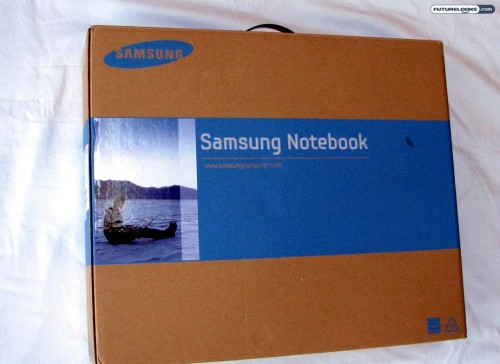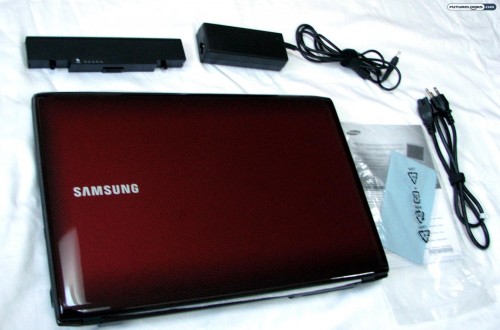
Not everyone who has a notebook is interested in taking the computer with them on the road. Instead, they just want the flexibility of using the laptop in any room in the home, operating as a desktop replacement more than anything else. Samsung’s Core i5 powered R780 seems geared towards that crowd. While far from being a high-end gaming rig for hardcore gamers, this 17.3-inch notebook PC is no slouch in the specs department either. And it has an attractive sub $1000 price point to boot.
Features and Specifications

The Samsung R780 is the 17-inch variant in the series that also includes the smaller 14-inch R480 and 15-inch R580, boasting slightly elevated specs in a larger package.
The configuration as tested in this review includes an Intel Core i5-430M processor with two cores running at 2.26Ghz and a 3MB shared cache. Inside, we find 4GB of DDR3 RAM, NVIDIA GeForce GT330M (1GB) graphics, 500GB hard drive, Super Multi Dual Layer optical disc drive, HD audio, 2W x 2 stereo speakers, and 1.3 megapixel webcam.
The 17.3-inch LED HD+ display boasts a 16:9 aspect ratio with a maximum resolution of 1600 x 900 pixels. Connectivity options include 802.11b/g/n, Gigabit LAN, Bluetooth 2.1+EDR, VGA-out, HDMI-out, and a multi-card reader. Windows 7 Home Premium 32 bit rounds off the specifications but it’s puzzling that the 64 bit variant isn’t installed due to the system’s 4GB of DDR3 RAM onboard. This means you’ll only be able to use 3.5GB of it.
The Samsung R780 is supposed to retail for under $1000 US but we’ve had a hard time locating a street price for it even with our shopping page. It’s little brother, the P580 seems a little easier to find but overall availability is a little scarce.
What’s in the Box?

Not surprisingly, there isn’t all that much to find when you crack open the box to the Samsung R780 notebook PC. In addition to the computer itself, you get a six-cell battery, power supply brick, and power cable, as well as a cleaning cloth and some basic documentation. Our unit did not come with a restore disk or driver disc which points to a secret partition on the drive that gives us that fail safe restore in case we completely pooch our system.
Still, the added cost of having discs at hand would have been nice especially if you want to do a completely clean installation and eliminate any “bloatware” that might be on the drive fresh from Samsung. It also would have been nice to have the disc to flip the OS to 64 bit.
Overall Design and Style
One thing you can say about Samsung these days is that they’re pretty darn consistent. Just about everything that I’ve seen lately comes with that Touch of Color aesthetic style and the R780 is no exception.
You get that same red-black color scheme throughout most of the visible portions of the notebook. This glossy look is certainly attractive, but it also happens to prominently display your fingerprints and dust. That’s why they include that cleaning cloth, you see.
I’m personally more of a fan of the smaller notebooks in the 13-inch range, so I did find the 17.3-inch R780 to be somewhat unwieldly. You do have to remember that this is a desktop replacement, though, so the form factor makes sense. The larger screen also makes productivity and long hours behind the screen somewhat more bearable. This eliminates the need for an external monitor immediately.
The port placement generally makes sense too with a couple of USB ports and the optical drive on the right. On the left are the power, VGA, LAN, HDMI, eSATA, USB, headphone, microphone, and ExpressCard. The multi-card reader is in the front.
Keyboard, Numeric Keypad, and Trackpad
The general feel of the keyboard on the Samsung R780 is similar in some ways to other Samsung portables with a chiclet-like style. This is generally comfortable, but it’s not without its faults.
For instance, the placement of the “\” key next to the left shift key resulted in more than a few typos on my part and likewise with the duplicated “\” key next to the main enter key. That was bothersome and I would have preferred a more traditional layout. The numeric keypad has become a mainstay for notebooks this size, so it’s pretty much par for the course to see it included too.
The trackpad has a slightly different, almost “textured” finish to it, offset from the glossy palm rest area. I found it to be reasonably smooth to use and the multi-touch gestures made web browsing a little easier. There are also small blue LEDs that light up the four corners of the trackpad, in case the change in texture wasn’t telling enough.
Display Quality and Viewing Angles
Considering that you are getting a large 17.3-inch display, it should almost be expected that Samsung would include a full HD screen for you. Unfortunately, that’s not the case. Instead of getting 1080p full HD (1920×1080), you get the less desirable 1600×900 resolution. This is “good enough,” I suppose, but it could be better.
You’ll also notice that they went with the ever-popular glossy finish. This generally results in more vibrant colors, which is good for gaming and movies, but it means you get all sorts of reflections in sunlight. I generally prefer matte, but I can understand why Samsung would go with glossy since it does sell the product better. But in all practicality, matte is definitely the way to go and it won’t take you 5 minutes to realize that perhaps you should have gotten the matte option (which isn’t available).
The overall display quality is pretty good with plenty of brightness, lots of contrast, and some super vibrant colors. It’s nothing like a top-end panel, but it’s a nice step above the low-end screens too. Well, that much is true if you are looking dead on center with this display. Both the horizontal and the vertical viewing angles could use some serious improvement. The screen becomes virtually unusable at wider angles, making it not at all effective for sharing with your nearby cubicle-mates.
The “sweet spot” is decidedly small and this is rather unfortunate. It’s also notable that the screen hinge doesn’t fold back all that far — about 120 degrees — so you’ll need to move your head or body to accommodate should the circumstances demand it. Since the size of the screen is so large, you tend to creep up on it quite quickly, which can lead to neck strain if you’re constantly trying to crane to hit the small sweet spot.
General Performance Experience
Putting the Samsung R780 through a usual day in the life of a freelance writer, I wasn’t disappointed (aside from the keyboard layout as described above). Watching high-def videos wasn’t an issue and surfing the web with Windows 7 Home Premium (32-bit) was as you’d expect it to be. Yes, this is a 32-bit version of Windows 7 installed, and of course, without the disc, you can’t do anything about that. This makes an upgrade to more memory somewhat pointless and it is rather puzzling that a 4GB equipped machine would not have 64 bit installed to take advantage of all the memory.
Battery life was on the average side: a fairly short 2 hrs while on balanced settings. Of course turning down the brightness on the large screen can increase that number, but with a smaller sweet spot, it’s hard to turn it down that much without suffering the consequences.
Next we’ll step through some benchmarks to give us some reference point as to how the Samsung R780 performs.
The Street Fighter IV Benchmark
To see how the Samsung R780 would perform as a gaming laptop, I used the official Street Fighter IV benchmark from Capcom. Though not the most stressful test, this DX9 title is close to my heart because I love fighting games.
For the first test, I maxed out most of the settings at 1600×900, anti-aliasing on, and most of the detail settings on maximum. This resulted in a rather sluggish experience, an average frame rate of 39.47 fps and a score of 5581 (D). The frame rate sounds okay, but I could see all kinds of delays and lag in the sample gameplay sequence.
To find more playable settings, I kept the native resolution of 1600×900 and tweaked high detail for character models and background, but turned off anti-aliasing and minimized other elements (particle rendering, motion blur, etc.). This resulted in a much better 59.32fps and a score of 9544 (A). From this, I can extrapolate that games on level with Street Fighter IV can be enjoyed with medium-level settings without too much trouble.
Other Benchmark Tests and Scores
The Samsung R780 is not a high-end gaming rig, but it can generally hold its own when it comes to most consumer-level tasks (including some gaming and multimedia editing). Running it through 3DMark06 Professional Edition, the R780 achieved an overall score of 6130, with an SM2.0 score of 2557, HDR/SM3.0 score of 2304, and a CPU score of 2579. This is actually lower than the 8793 3DMarks achieved by the Asus G51Vx gaming notebook we tested last year. This appears to be due to the graphics card rather than the processor.
While it wasn’t able to compute an overall score in PCMark05 Professional Edition, the benchmark was able to generate a CPU score of 6641, memory score of 5710, graphics score of 6481, and a HDD score of 4884. Again compared to the Asus G51Vx, we find that the Samsung outperformed it in the processor and memory departments. However, the Asus was able to achieve a graphics score of 11208, which is nearly double that of the Samsung R780.
In HD Tune 2.55, the provided 500GB hard drive had an average transfer rate of 62.3MB/sec with a 33.1MB/sec minimum and 79.4MB/sec maximum. The access time was clocked at 19.1ms with a burst rate of 65.6MB/sec. Definitely a major bottlekneck of the system or any notebook is the hard drive.
Closing Thoughts
Considering that the Samsung R780 hits that magical sub-$1000 price point, I’d say that it offers a fair bit of value for money. You get a large 17.3-inch LED HD+ display with great vibrant colors and a decent 1600×900 pixel resolution. I would have liked true 1080p and a Blu-ray player, but those may have bumped the price into four figures.
Build quality is generally good and Samsung has once again done a great job with aesthetics. I’m not a fan of some of the keyboard quirks, but that’s something you can get used to over time. The graphics card isn’t the most powerful thing in the world, but you can enjoy most contemporary games on medium-level settings. Plugged into the wall, the 2 hr battery life shouldn’t bother you, but be prepared to share an outlet at the local coffee shop.
In the end, the Samsung R780 represents a pretty good deal if you’re looking for a desktop replacement. That is, if you can find one.
Pros
- Affordable price point for gaming notebook
- Eye-catching style and design
- Generally decent performance overall (at this price)
- Multi-touch trackpad gestures
Cons
- Short battery life (about two hours with regular use)
- Bad placement of ” \ ” keys on keyboard
- Only comes with 32-bit Windows 7
Overall Rating: 7.5/10.0
Love This Review? Hate This Review? Leave a Comment or Hit the Forums!
Samsung R780 17-Inch Core i5 Notebook – Photo Gallery
You skipped our conclusion! Head back a page to find out what we thought!
